Leadership's Role: Managing People Through Organizational Change
VerifiedAdded on 2023/04/21
|18
|5566
|143
Report
AI Summary
This report examines the critical role of skilled leadership in organizational change, emphasizing the necessary skills, proficiencies, and knowledge for effective change management. It explores the relationship between leaders, line managers, and HR representatives, highlighting the importance of visionary and innovative leadership in today's competitive environment. The report reviews organizational leadership theories such as Contingency Theory, Path-Goal Theory, and Transformational Theory, and underscores the significance of change in organizations. The Apple case study is used as an example. It concludes by emphasizing the importance of a strong leader-HR relationship for successful organizational change. Desklib offers more resources for students.
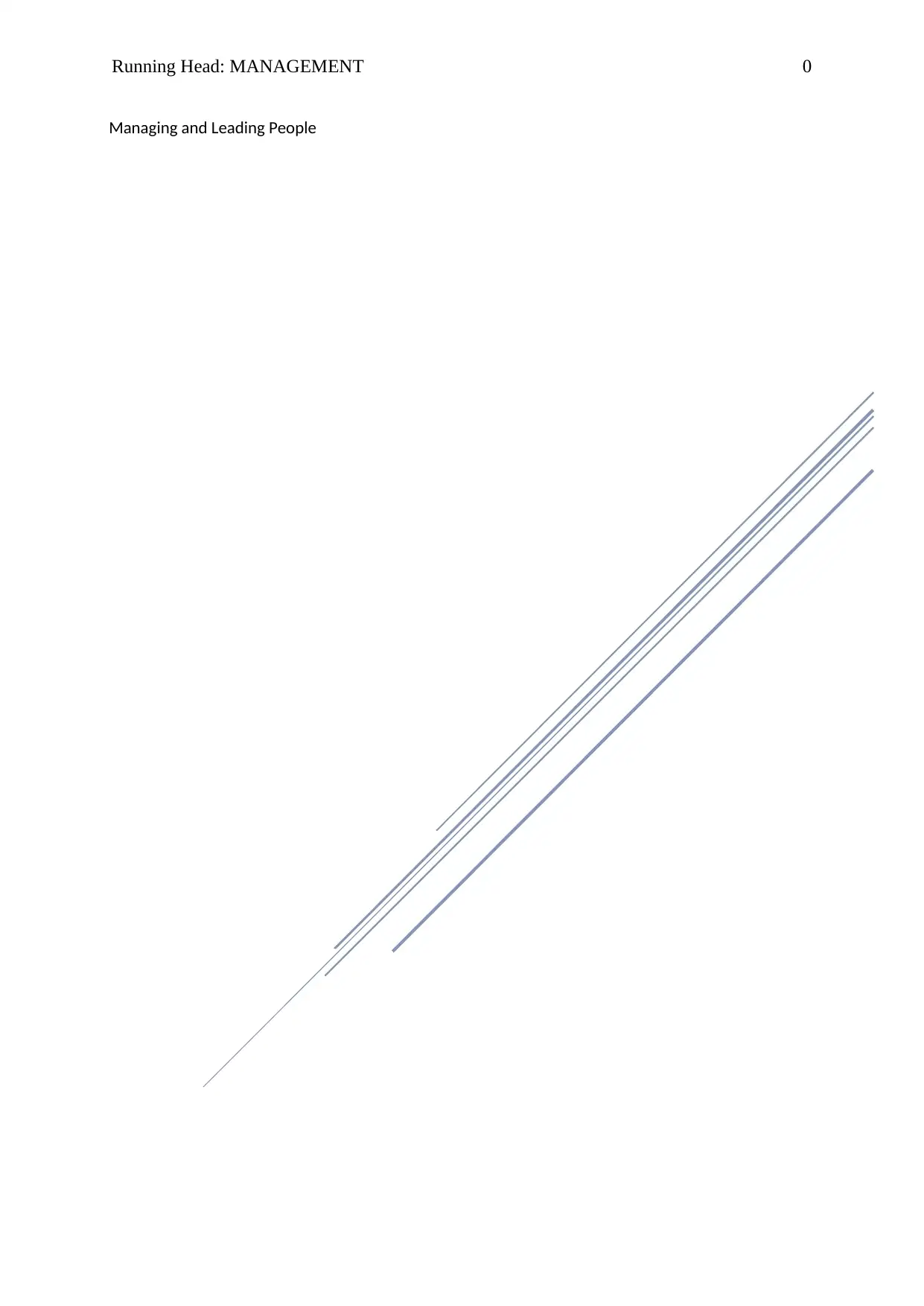
Running Head: MANAGEMENT 0
Managing and Leading People
Managing and Leading People
Paraphrase This Document
Need a fresh take? Get an instant paraphrase of this document with our AI Paraphraser
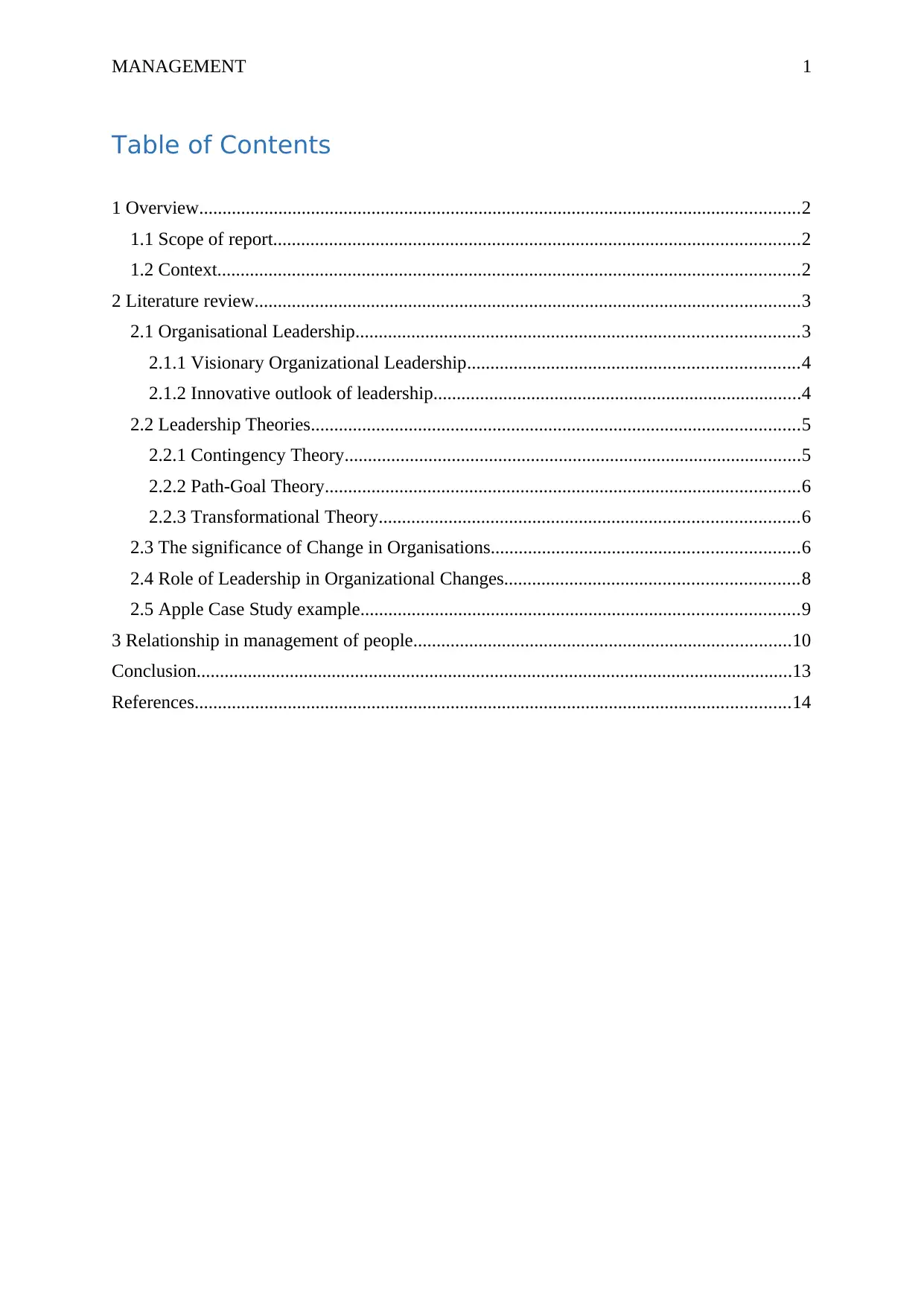
MANAGEMENT 1
Table of Contents
1 Overview.................................................................................................................................2
1.1 Scope of report.................................................................................................................2
1.2 Context.............................................................................................................................2
2 Literature review.....................................................................................................................3
2.1 Organisational Leadership...............................................................................................3
2.1.1 Visionary Organizational Leadership.......................................................................4
2.1.2 Innovative outlook of leadership...............................................................................4
2.2 Leadership Theories.........................................................................................................5
2.2.1 Contingency Theory..................................................................................................5
2.2.2 Path-Goal Theory......................................................................................................6
2.2.3 Transformational Theory..........................................................................................6
2.3 The significance of Change in Organisations..................................................................6
2.4 Role of Leadership in Organizational Changes...............................................................8
2.5 Apple Case Study example..............................................................................................9
3 Relationship in management of people.................................................................................10
Conclusion................................................................................................................................13
References................................................................................................................................14
Table of Contents
1 Overview.................................................................................................................................2
1.1 Scope of report.................................................................................................................2
1.2 Context.............................................................................................................................2
2 Literature review.....................................................................................................................3
2.1 Organisational Leadership...............................................................................................3
2.1.1 Visionary Organizational Leadership.......................................................................4
2.1.2 Innovative outlook of leadership...............................................................................4
2.2 Leadership Theories.........................................................................................................5
2.2.1 Contingency Theory..................................................................................................5
2.2.2 Path-Goal Theory......................................................................................................6
2.2.3 Transformational Theory..........................................................................................6
2.3 The significance of Change in Organisations..................................................................6
2.4 Role of Leadership in Organizational Changes...............................................................8
2.5 Apple Case Study example..............................................................................................9
3 Relationship in management of people.................................................................................10
Conclusion................................................................................................................................13
References................................................................................................................................14
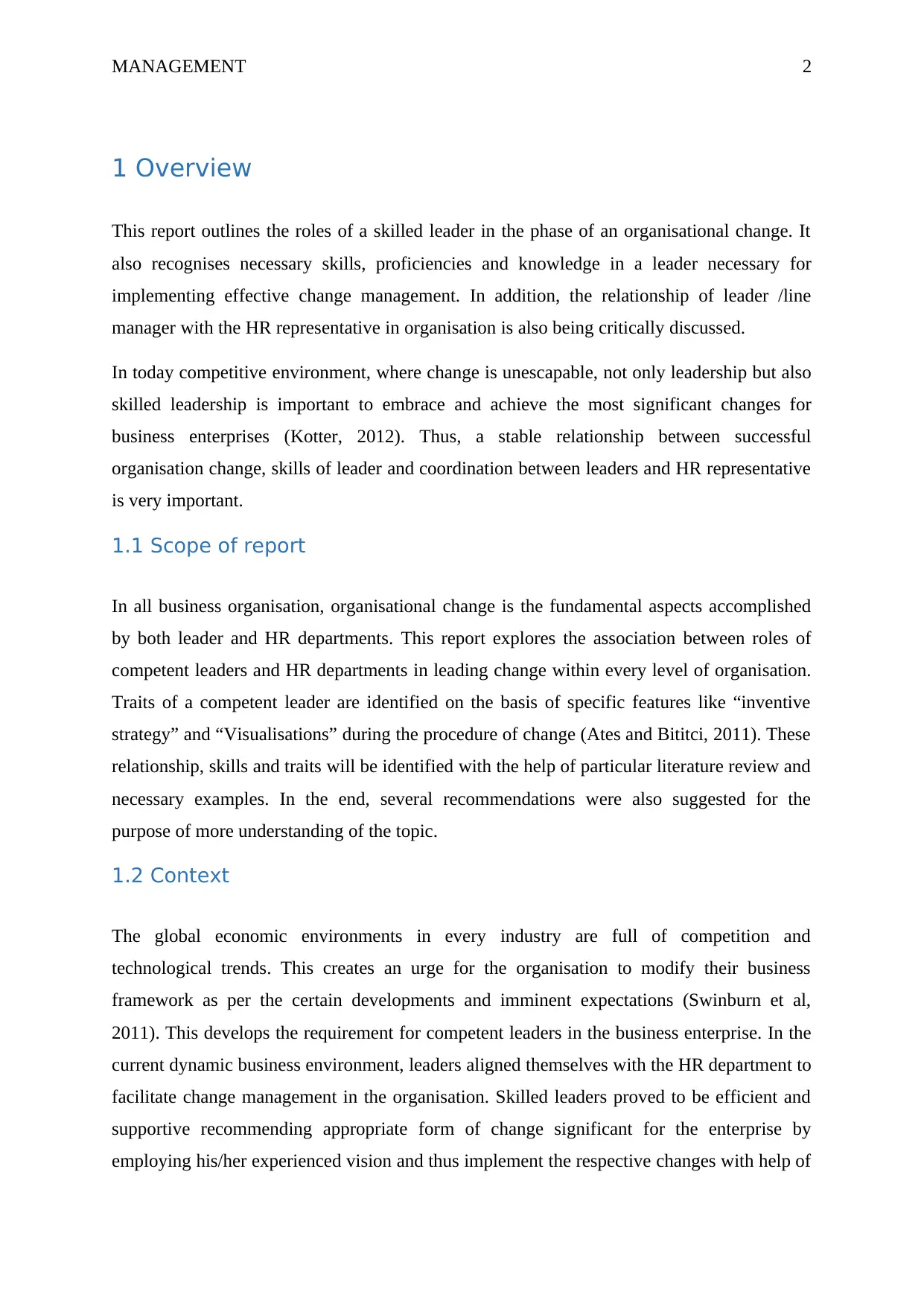
MANAGEMENT 2
1 Overview
This report outlines the roles of a skilled leader in the phase of an organisational change. It
also recognises necessary skills, proficiencies and knowledge in a leader necessary for
implementing effective change management. In addition, the relationship of leader /line
manager with the HR representative in organisation is also being critically discussed.
In today competitive environment, where change is unescapable, not only leadership but also
skilled leadership is important to embrace and achieve the most significant changes for
business enterprises (Kotter, 2012). Thus, a stable relationship between successful
organisation change, skills of leader and coordination between leaders and HR representative
is very important.
1.1 Scope of report
In all business organisation, organisational change is the fundamental aspects accomplished
by both leader and HR departments. This report explores the association between roles of
competent leaders and HR departments in leading change within every level of organisation.
Traits of a competent leader are identified on the basis of specific features like “inventive
strategy” and “Visualisations” during the procedure of change (Ates and Bititci, 2011). These
relationship, skills and traits will be identified with the help of particular literature review and
necessary examples. In the end, several recommendations were also suggested for the
purpose of more understanding of the topic.
1.2 Context
The global economic environments in every industry are full of competition and
technological trends. This creates an urge for the organisation to modify their business
framework as per the certain developments and imminent expectations (Swinburn et al,
2011). This develops the requirement for competent leaders in the business enterprise. In the
current dynamic business environment, leaders aligned themselves with the HR department to
facilitate change management in the organisation. Skilled leaders proved to be efficient and
supportive recommending appropriate form of change significant for the enterprise by
employing his/her experienced vision and thus implement the respective changes with help of
1 Overview
This report outlines the roles of a skilled leader in the phase of an organisational change. It
also recognises necessary skills, proficiencies and knowledge in a leader necessary for
implementing effective change management. In addition, the relationship of leader /line
manager with the HR representative in organisation is also being critically discussed.
In today competitive environment, where change is unescapable, not only leadership but also
skilled leadership is important to embrace and achieve the most significant changes for
business enterprises (Kotter, 2012). Thus, a stable relationship between successful
organisation change, skills of leader and coordination between leaders and HR representative
is very important.
1.1 Scope of report
In all business organisation, organisational change is the fundamental aspects accomplished
by both leader and HR departments. This report explores the association between roles of
competent leaders and HR departments in leading change within every level of organisation.
Traits of a competent leader are identified on the basis of specific features like “inventive
strategy” and “Visualisations” during the procedure of change (Ates and Bititci, 2011). These
relationship, skills and traits will be identified with the help of particular literature review and
necessary examples. In the end, several recommendations were also suggested for the
purpose of more understanding of the topic.
1.2 Context
The global economic environments in every industry are full of competition and
technological trends. This creates an urge for the organisation to modify their business
framework as per the certain developments and imminent expectations (Swinburn et al,
2011). This develops the requirement for competent leaders in the business enterprise. In the
current dynamic business environment, leaders aligned themselves with the HR department to
facilitate change management in the organisation. Skilled leaders proved to be efficient and
supportive recommending appropriate form of change significant for the enterprise by
employing his/her experienced vision and thus implement the respective changes with help of
⊘ This is a preview!⊘
Do you want full access?
Subscribe today to unlock all pages.

Trusted by 1+ million students worldwide
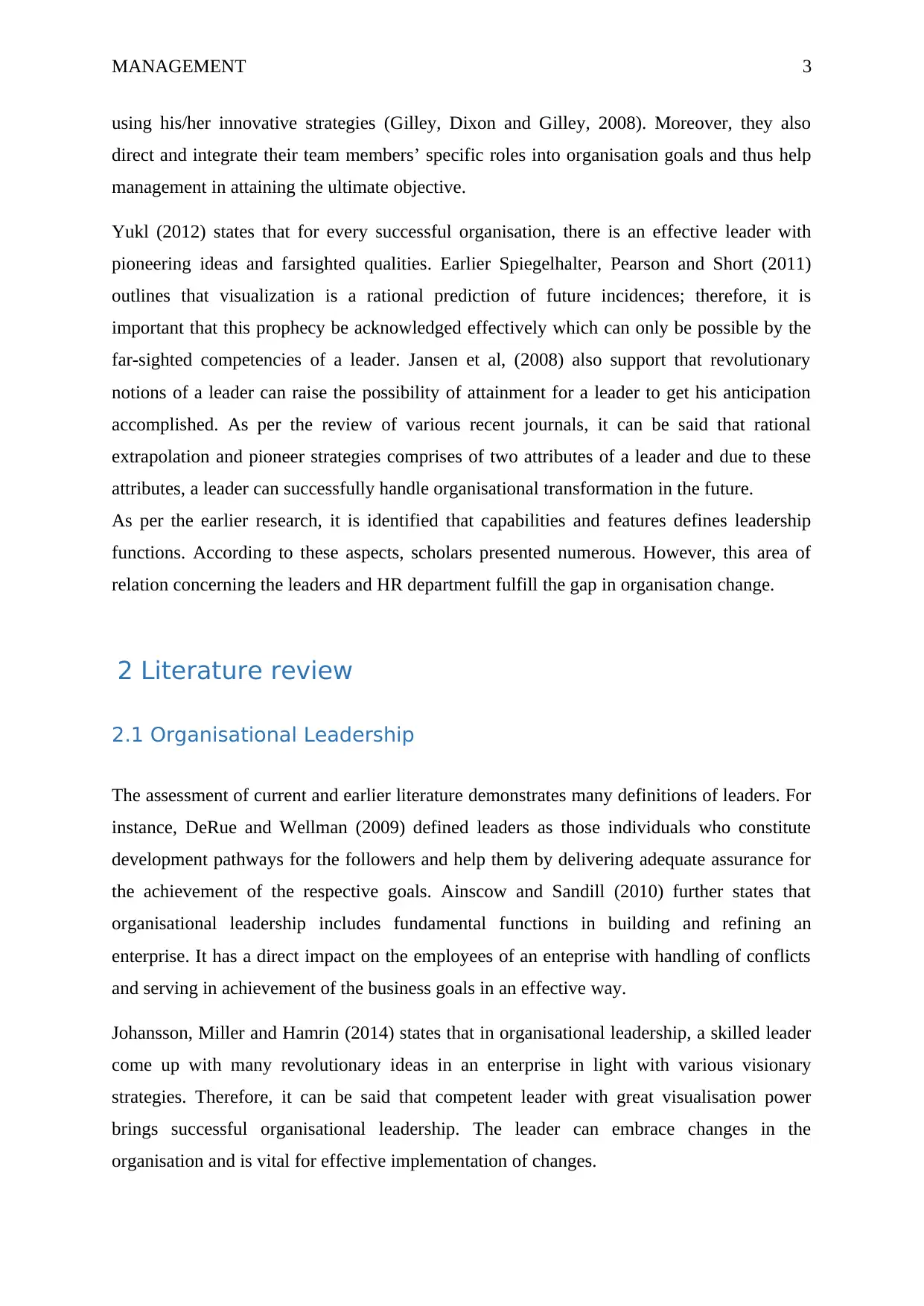
MANAGEMENT 3
using his/her innovative strategies (Gilley, Dixon and Gilley, 2008). Moreover, they also
direct and integrate their team members’ specific roles into organisation goals and thus help
management in attaining the ultimate objective.
Yukl (2012) states that for every successful organisation, there is an effective leader with
pioneering ideas and farsighted qualities. Earlier Spiegelhalter, Pearson and Short (2011)
outlines that visualization is a rational prediction of future incidences; therefore, it is
important that this prophecy be acknowledged effectively which can only be possible by the
far-sighted competencies of a leader. Jansen et al, (2008) also support that revolutionary
notions of a leader can raise the possibility of attainment for a leader to get his anticipation
accomplished. As per the review of various recent journals, it can be said that rational
extrapolation and pioneer strategies comprises of two attributes of a leader and due to these
attributes, a leader can successfully handle organisational transformation in the future.
As per the earlier research, it is identified that capabilities and features defines leadership
functions. According to these aspects, scholars presented numerous. However, this area of
relation concerning the leaders and HR department fulfill the gap in organisation change.
2 Literature review
2.1 Organisational Leadership
The assessment of current and earlier literature demonstrates many definitions of leaders. For
instance, DeRue and Wellman (2009) defined leaders as those individuals who constitute
development pathways for the followers and help them by delivering adequate assurance for
the achievement of the respective goals. Ainscow and Sandill (2010) further states that
organisational leadership includes fundamental functions in building and refining an
enterprise. It has a direct impact on the employees of an enteprise with handling of conflicts
and serving in achievement of the business goals in an effective way.
Johansson, Miller and Hamrin (2014) states that in organisational leadership, a skilled leader
come up with many revolutionary ideas in an enterprise in light with various visionary
strategies. Therefore, it can be said that competent leader with great visualisation power
brings successful organisational leadership. The leader can embrace changes in the
organisation and is vital for effective implementation of changes.
using his/her innovative strategies (Gilley, Dixon and Gilley, 2008). Moreover, they also
direct and integrate their team members’ specific roles into organisation goals and thus help
management in attaining the ultimate objective.
Yukl (2012) states that for every successful organisation, there is an effective leader with
pioneering ideas and farsighted qualities. Earlier Spiegelhalter, Pearson and Short (2011)
outlines that visualization is a rational prediction of future incidences; therefore, it is
important that this prophecy be acknowledged effectively which can only be possible by the
far-sighted competencies of a leader. Jansen et al, (2008) also support that revolutionary
notions of a leader can raise the possibility of attainment for a leader to get his anticipation
accomplished. As per the review of various recent journals, it can be said that rational
extrapolation and pioneer strategies comprises of two attributes of a leader and due to these
attributes, a leader can successfully handle organisational transformation in the future.
As per the earlier research, it is identified that capabilities and features defines leadership
functions. According to these aspects, scholars presented numerous. However, this area of
relation concerning the leaders and HR department fulfill the gap in organisation change.
2 Literature review
2.1 Organisational Leadership
The assessment of current and earlier literature demonstrates many definitions of leaders. For
instance, DeRue and Wellman (2009) defined leaders as those individuals who constitute
development pathways for the followers and help them by delivering adequate assurance for
the achievement of the respective goals. Ainscow and Sandill (2010) further states that
organisational leadership includes fundamental functions in building and refining an
enterprise. It has a direct impact on the employees of an enteprise with handling of conflicts
and serving in achievement of the business goals in an effective way.
Johansson, Miller and Hamrin (2014) states that in organisational leadership, a skilled leader
come up with many revolutionary ideas in an enterprise in light with various visionary
strategies. Therefore, it can be said that competent leader with great visualisation power
brings successful organisational leadership. The leader can embrace changes in the
organisation and is vital for effective implementation of changes.
Paraphrase This Document
Need a fresh take? Get an instant paraphrase of this document with our AI Paraphraser
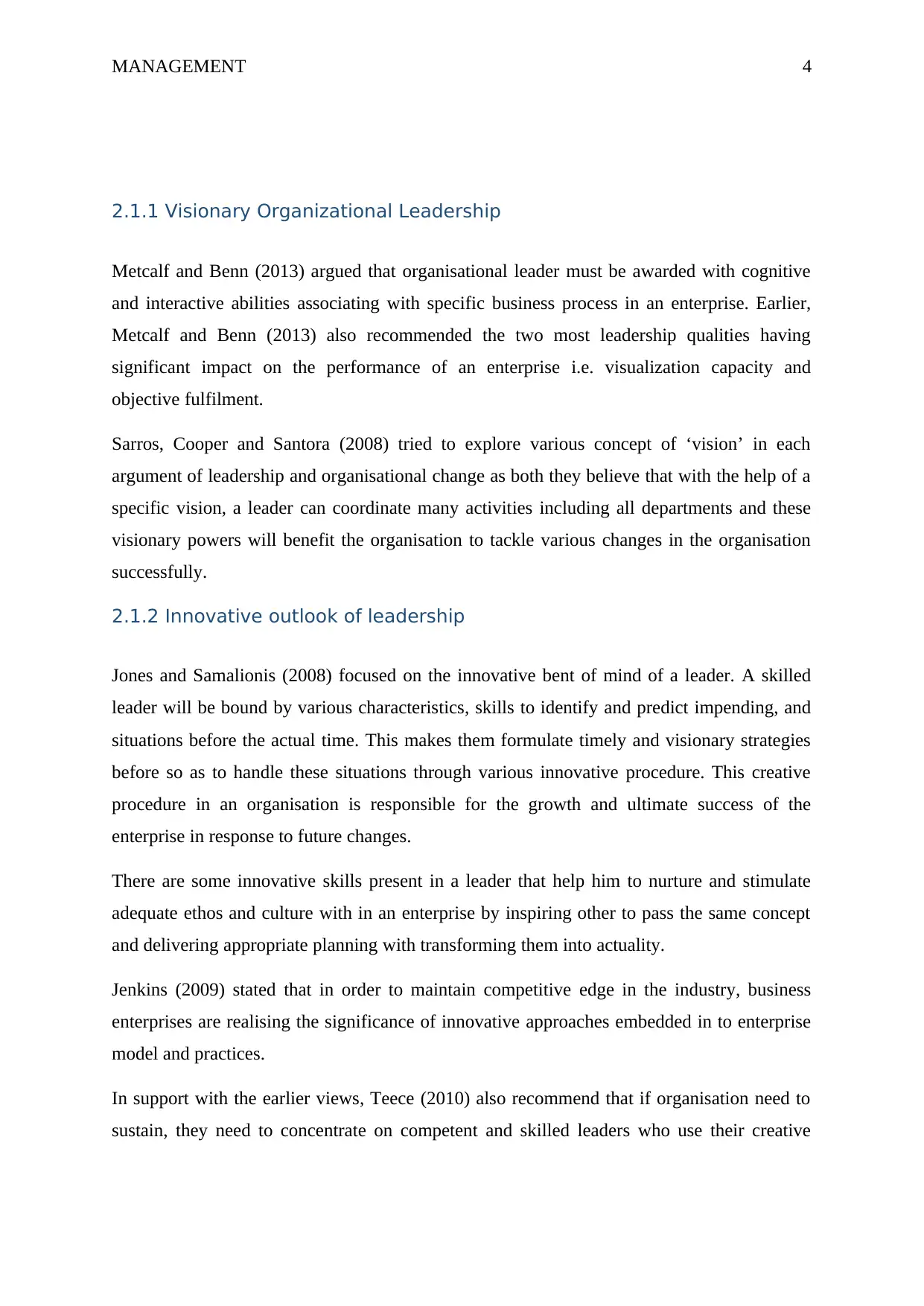
MANAGEMENT 4
2.1.1 Visionary Organizational Leadership
Metcalf and Benn (2013) argued that organisational leader must be awarded with cognitive
and interactive abilities associating with specific business process in an enterprise. Earlier,
Metcalf and Benn (2013) also recommended the two most leadership qualities having
significant impact on the performance of an enterprise i.e. visualization capacity and
objective fulfilment.
Sarros, Cooper and Santora (2008) tried to explore various concept of ‘vision’ in each
argument of leadership and organisational change as both they believe that with the help of a
specific vision, a leader can coordinate many activities including all departments and these
visionary powers will benefit the organisation to tackle various changes in the organisation
successfully.
2.1.2 Innovative outlook of leadership
Jones and Samalionis (2008) focused on the innovative bent of mind of a leader. A skilled
leader will be bound by various characteristics, skills to identify and predict impending, and
situations before the actual time. This makes them formulate timely and visionary strategies
before so as to handle these situations through various innovative procedure. This creative
procedure in an organisation is responsible for the growth and ultimate success of the
enterprise in response to future changes.
There are some innovative skills present in a leader that help him to nurture and stimulate
adequate ethos and culture with in an enterprise by inspiring other to pass the same concept
and delivering appropriate planning with transforming them into actuality.
Jenkins (2009) stated that in order to maintain competitive edge in the industry, business
enterprises are realising the significance of innovative approaches embedded in to enterprise
model and practices.
In support with the earlier views, Teece (2010) also recommend that if organisation need to
sustain, they need to concentrate on competent and skilled leaders who use their creative
2.1.1 Visionary Organizational Leadership
Metcalf and Benn (2013) argued that organisational leader must be awarded with cognitive
and interactive abilities associating with specific business process in an enterprise. Earlier,
Metcalf and Benn (2013) also recommended the two most leadership qualities having
significant impact on the performance of an enterprise i.e. visualization capacity and
objective fulfilment.
Sarros, Cooper and Santora (2008) tried to explore various concept of ‘vision’ in each
argument of leadership and organisational change as both they believe that with the help of a
specific vision, a leader can coordinate many activities including all departments and these
visionary powers will benefit the organisation to tackle various changes in the organisation
successfully.
2.1.2 Innovative outlook of leadership
Jones and Samalionis (2008) focused on the innovative bent of mind of a leader. A skilled
leader will be bound by various characteristics, skills to identify and predict impending, and
situations before the actual time. This makes them formulate timely and visionary strategies
before so as to handle these situations through various innovative procedure. This creative
procedure in an organisation is responsible for the growth and ultimate success of the
enterprise in response to future changes.
There are some innovative skills present in a leader that help him to nurture and stimulate
adequate ethos and culture with in an enterprise by inspiring other to pass the same concept
and delivering appropriate planning with transforming them into actuality.
Jenkins (2009) stated that in order to maintain competitive edge in the industry, business
enterprises are realising the significance of innovative approaches embedded in to enterprise
model and practices.
In support with the earlier views, Teece (2010) also recommend that if organisation need to
sustain, they need to concentrate on competent and skilled leaders who use their creative
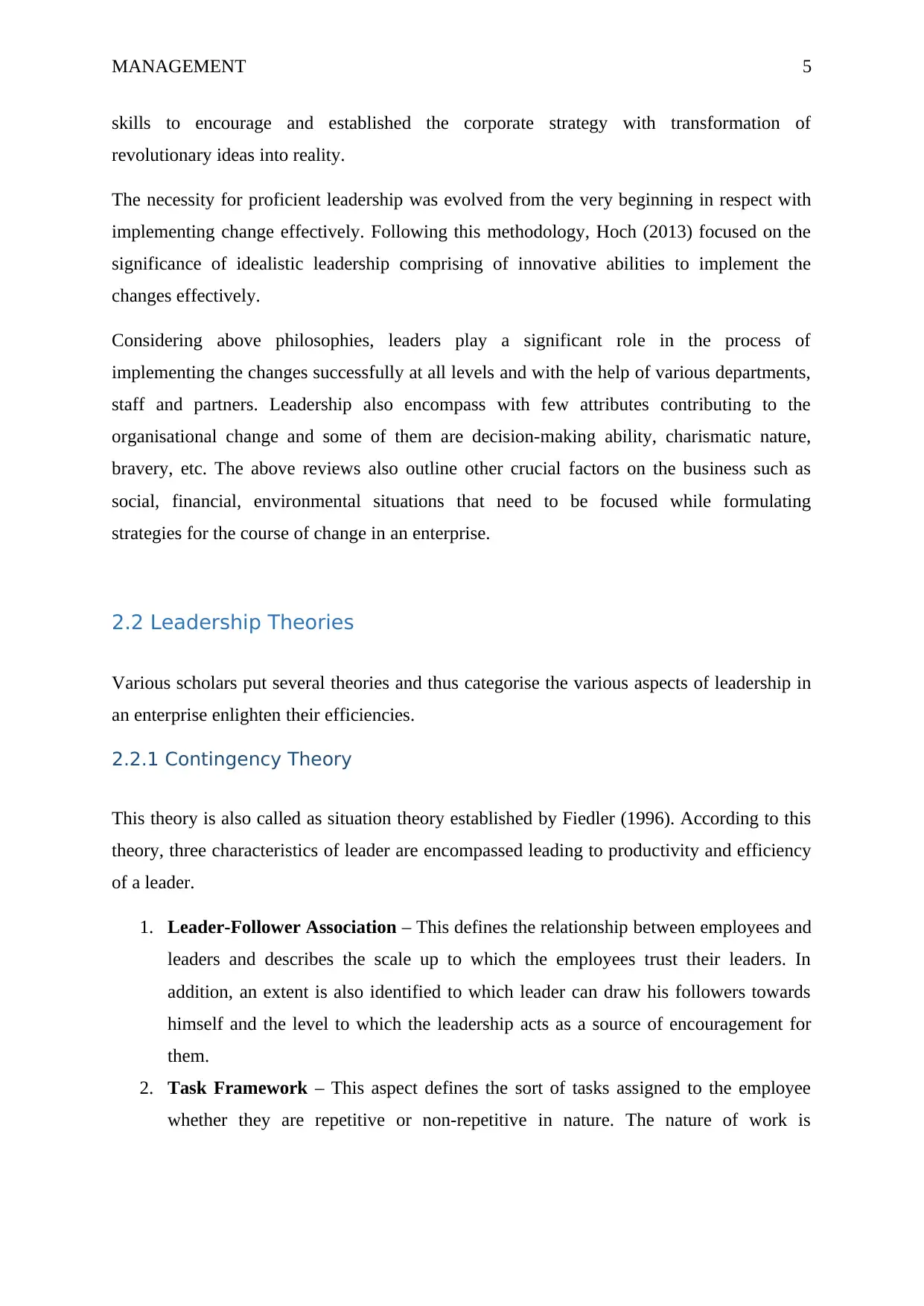
MANAGEMENT 5
skills to encourage and established the corporate strategy with transformation of
revolutionary ideas into reality.
The necessity for proficient leadership was evolved from the very beginning in respect with
implementing change effectively. Following this methodology, Hoch (2013) focused on the
significance of idealistic leadership comprising of innovative abilities to implement the
changes effectively.
Considering above philosophies, leaders play a significant role in the process of
implementing the changes successfully at all levels and with the help of various departments,
staff and partners. Leadership also encompass with few attributes contributing to the
organisational change and some of them are decision-making ability, charismatic nature,
bravery, etc. The above reviews also outline other crucial factors on the business such as
social, financial, environmental situations that need to be focused while formulating
strategies for the course of change in an enterprise.
2.2 Leadership Theories
Various scholars put several theories and thus categorise the various aspects of leadership in
an enterprise enlighten their efficiencies.
2.2.1 Contingency Theory
This theory is also called as situation theory established by Fiedler (1996). According to this
theory, three characteristics of leader are encompassed leading to productivity and efficiency
of a leader.
1. Leader-Follower Association – This defines the relationship between employees and
leaders and describes the scale up to which the employees trust their leaders. In
addition, an extent is also identified to which leader can draw his followers towards
himself and the level to which the leadership acts as a source of encouragement for
them.
2. Task Framework – This aspect defines the sort of tasks assigned to the employee
whether they are repetitive or non-repetitive in nature. The nature of work is
skills to encourage and established the corporate strategy with transformation of
revolutionary ideas into reality.
The necessity for proficient leadership was evolved from the very beginning in respect with
implementing change effectively. Following this methodology, Hoch (2013) focused on the
significance of idealistic leadership comprising of innovative abilities to implement the
changes effectively.
Considering above philosophies, leaders play a significant role in the process of
implementing the changes successfully at all levels and with the help of various departments,
staff and partners. Leadership also encompass with few attributes contributing to the
organisational change and some of them are decision-making ability, charismatic nature,
bravery, etc. The above reviews also outline other crucial factors on the business such as
social, financial, environmental situations that need to be focused while formulating
strategies for the course of change in an enterprise.
2.2 Leadership Theories
Various scholars put several theories and thus categorise the various aspects of leadership in
an enterprise enlighten their efficiencies.
2.2.1 Contingency Theory
This theory is also called as situation theory established by Fiedler (1996). According to this
theory, three characteristics of leader are encompassed leading to productivity and efficiency
of a leader.
1. Leader-Follower Association – This defines the relationship between employees and
leaders and describes the scale up to which the employees trust their leaders. In
addition, an extent is also identified to which leader can draw his followers towards
himself and the level to which the leadership acts as a source of encouragement for
them.
2. Task Framework – This aspect defines the sort of tasks assigned to the employee
whether they are repetitive or non-repetitive in nature. The nature of work is
⊘ This is a preview!⊘
Do you want full access?
Subscribe today to unlock all pages.

Trusted by 1+ million students worldwide
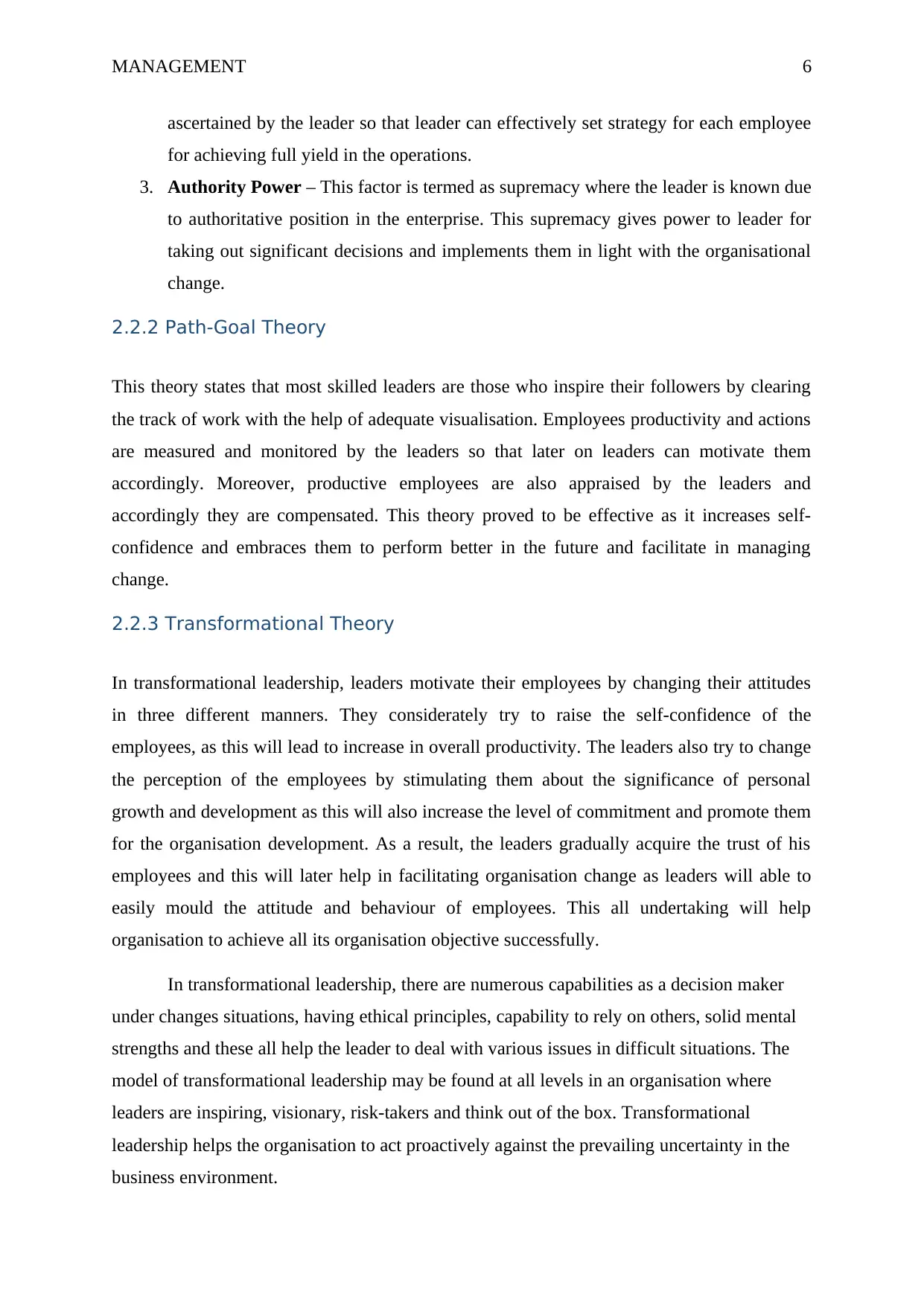
MANAGEMENT 6
ascertained by the leader so that leader can effectively set strategy for each employee
for achieving full yield in the operations.
3. Authority Power – This factor is termed as supremacy where the leader is known due
to authoritative position in the enterprise. This supremacy gives power to leader for
taking out significant decisions and implements them in light with the organisational
change.
2.2.2 Path-Goal Theory
This theory states that most skilled leaders are those who inspire their followers by clearing
the track of work with the help of adequate visualisation. Employees productivity and actions
are measured and monitored by the leaders so that later on leaders can motivate them
accordingly. Moreover, productive employees are also appraised by the leaders and
accordingly they are compensated. This theory proved to be effective as it increases self-
confidence and embraces them to perform better in the future and facilitate in managing
change.
2.2.3 Transformational Theory
In transformational leadership, leaders motivate their employees by changing their attitudes
in three different manners. They considerately try to raise the self-confidence of the
employees, as this will lead to increase in overall productivity. The leaders also try to change
the perception of the employees by stimulating them about the significance of personal
growth and development as this will also increase the level of commitment and promote them
for the organisation development. As a result, the leaders gradually acquire the trust of his
employees and this will later help in facilitating organisation change as leaders will able to
easily mould the attitude and behaviour of employees. This all undertaking will help
organisation to achieve all its organisation objective successfully.
In transformational leadership, there are numerous capabilities as a decision maker
under changes situations, having ethical principles, capability to rely on others, solid mental
strengths and these all help the leader to deal with various issues in difficult situations. The
model of transformational leadership may be found at all levels in an organisation where
leaders are inspiring, visionary, risk-takers and think out of the box. Transformational
leadership helps the organisation to act proactively against the prevailing uncertainty in the
business environment.
ascertained by the leader so that leader can effectively set strategy for each employee
for achieving full yield in the operations.
3. Authority Power – This factor is termed as supremacy where the leader is known due
to authoritative position in the enterprise. This supremacy gives power to leader for
taking out significant decisions and implements them in light with the organisational
change.
2.2.2 Path-Goal Theory
This theory states that most skilled leaders are those who inspire their followers by clearing
the track of work with the help of adequate visualisation. Employees productivity and actions
are measured and monitored by the leaders so that later on leaders can motivate them
accordingly. Moreover, productive employees are also appraised by the leaders and
accordingly they are compensated. This theory proved to be effective as it increases self-
confidence and embraces them to perform better in the future and facilitate in managing
change.
2.2.3 Transformational Theory
In transformational leadership, leaders motivate their employees by changing their attitudes
in three different manners. They considerately try to raise the self-confidence of the
employees, as this will lead to increase in overall productivity. The leaders also try to change
the perception of the employees by stimulating them about the significance of personal
growth and development as this will also increase the level of commitment and promote them
for the organisation development. As a result, the leaders gradually acquire the trust of his
employees and this will later help in facilitating organisation change as leaders will able to
easily mould the attitude and behaviour of employees. This all undertaking will help
organisation to achieve all its organisation objective successfully.
In transformational leadership, there are numerous capabilities as a decision maker
under changes situations, having ethical principles, capability to rely on others, solid mental
strengths and these all help the leader to deal with various issues in difficult situations. The
model of transformational leadership may be found at all levels in an organisation where
leaders are inspiring, visionary, risk-takers and think out of the box. Transformational
leadership helps the organisation to act proactively against the prevailing uncertainty in the
business environment.
Paraphrase This Document
Need a fresh take? Get an instant paraphrase of this document with our AI Paraphraser
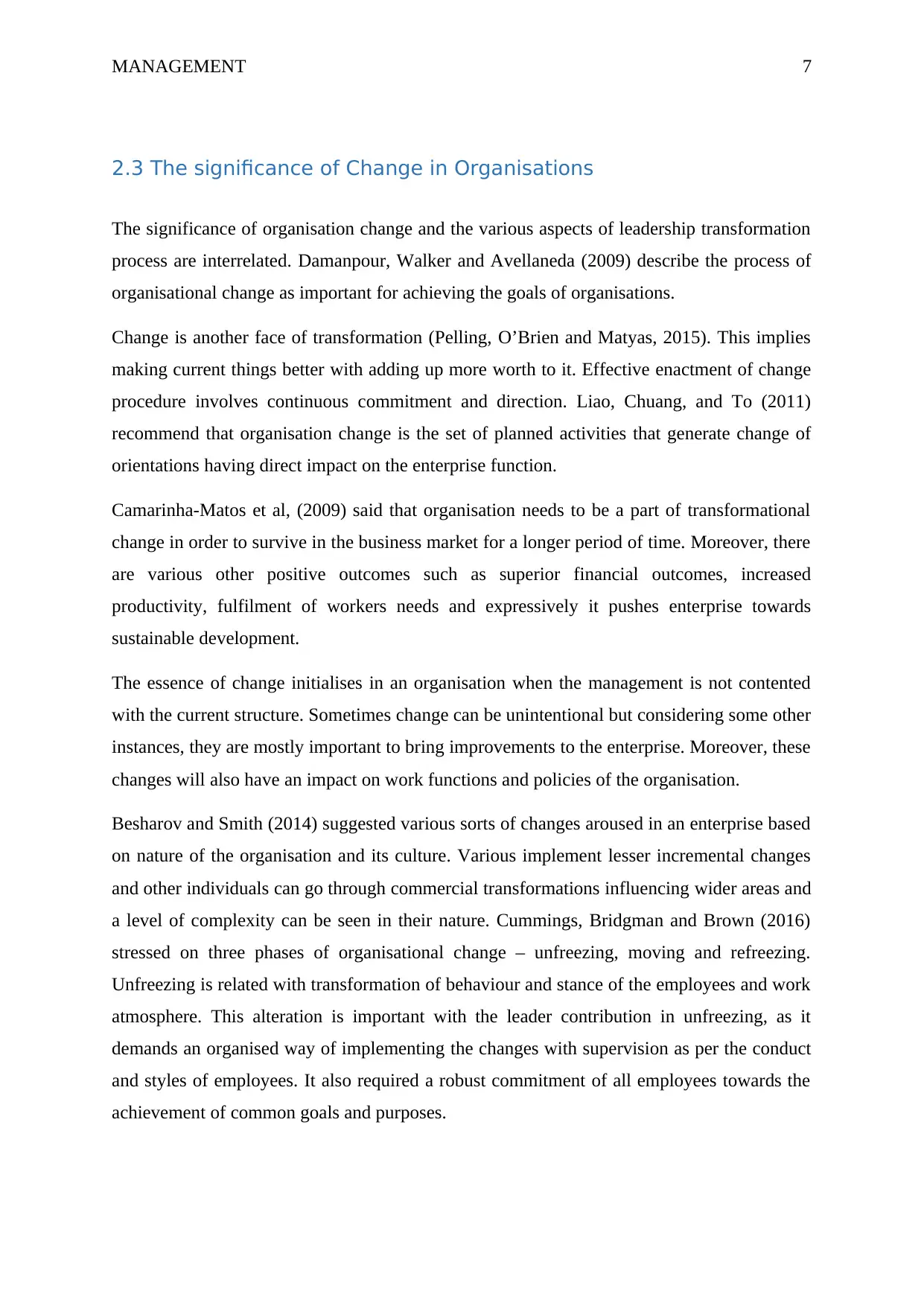
MANAGEMENT 7
2.3 The significance of Change in Organisations
The significance of organisation change and the various aspects of leadership transformation
process are interrelated. Damanpour, Walker and Avellaneda (2009) describe the process of
organisational change as important for achieving the goals of organisations.
Change is another face of transformation (Pelling, O’Brien and Matyas, 2015). This implies
making current things better with adding up more worth to it. Effective enactment of change
procedure involves continuous commitment and direction. Liao, Chuang, and To (2011)
recommend that organisation change is the set of planned activities that generate change of
orientations having direct impact on the enterprise function.
Camarinha-Matos et al, (2009) said that organisation needs to be a part of transformational
change in order to survive in the business market for a longer period of time. Moreover, there
are various other positive outcomes such as superior financial outcomes, increased
productivity, fulfilment of workers needs and expressively it pushes enterprise towards
sustainable development.
The essence of change initialises in an organisation when the management is not contented
with the current structure. Sometimes change can be unintentional but considering some other
instances, they are mostly important to bring improvements to the enterprise. Moreover, these
changes will also have an impact on work functions and policies of the organisation.
Besharov and Smith (2014) suggested various sorts of changes aroused in an enterprise based
on nature of the organisation and its culture. Various implement lesser incremental changes
and other individuals can go through commercial transformations influencing wider areas and
a level of complexity can be seen in their nature. Cummings, Bridgman and Brown (2016)
stressed on three phases of organisational change – unfreezing, moving and refreezing.
Unfreezing is related with transformation of behaviour and stance of the employees and work
atmosphere. This alteration is important with the leader contribution in unfreezing, as it
demands an organised way of implementing the changes with supervision as per the conduct
and styles of employees. It also required a robust commitment of all employees towards the
achievement of common goals and purposes.
2.3 The significance of Change in Organisations
The significance of organisation change and the various aspects of leadership transformation
process are interrelated. Damanpour, Walker and Avellaneda (2009) describe the process of
organisational change as important for achieving the goals of organisations.
Change is another face of transformation (Pelling, O’Brien and Matyas, 2015). This implies
making current things better with adding up more worth to it. Effective enactment of change
procedure involves continuous commitment and direction. Liao, Chuang, and To (2011)
recommend that organisation change is the set of planned activities that generate change of
orientations having direct impact on the enterprise function.
Camarinha-Matos et al, (2009) said that organisation needs to be a part of transformational
change in order to survive in the business market for a longer period of time. Moreover, there
are various other positive outcomes such as superior financial outcomes, increased
productivity, fulfilment of workers needs and expressively it pushes enterprise towards
sustainable development.
The essence of change initialises in an organisation when the management is not contented
with the current structure. Sometimes change can be unintentional but considering some other
instances, they are mostly important to bring improvements to the enterprise. Moreover, these
changes will also have an impact on work functions and policies of the organisation.
Besharov and Smith (2014) suggested various sorts of changes aroused in an enterprise based
on nature of the organisation and its culture. Various implement lesser incremental changes
and other individuals can go through commercial transformations influencing wider areas and
a level of complexity can be seen in their nature. Cummings, Bridgman and Brown (2016)
stressed on three phases of organisational change – unfreezing, moving and refreezing.
Unfreezing is related with transformation of behaviour and stance of the employees and work
atmosphere. This alteration is important with the leader contribution in unfreezing, as it
demands an organised way of implementing the changes with supervision as per the conduct
and styles of employees. It also required a robust commitment of all employees towards the
achievement of common goals and purposes.
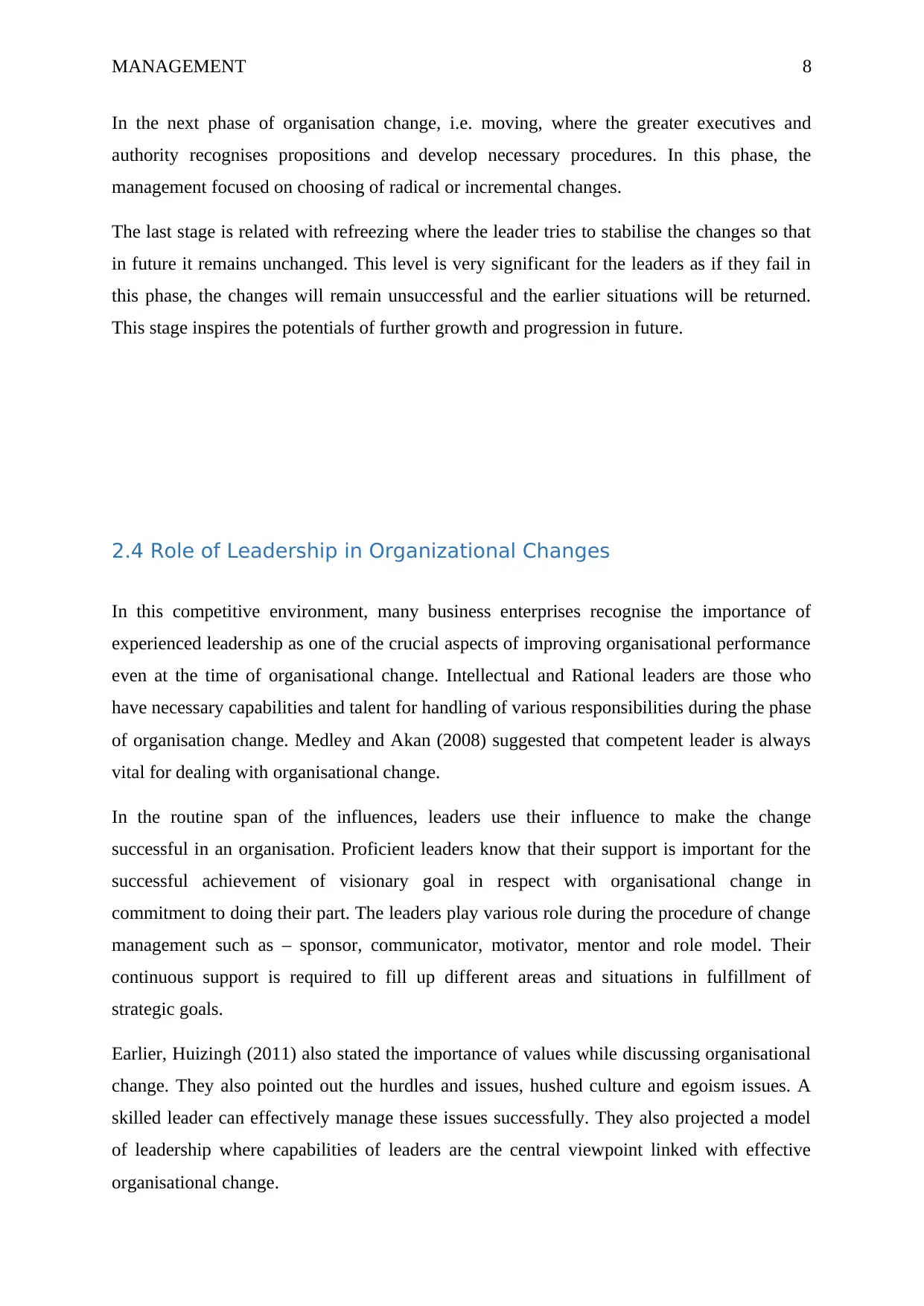
MANAGEMENT 8
In the next phase of organisation change, i.e. moving, where the greater executives and
authority recognises propositions and develop necessary procedures. In this phase, the
management focused on choosing of radical or incremental changes.
The last stage is related with refreezing where the leader tries to stabilise the changes so that
in future it remains unchanged. This level is very significant for the leaders as if they fail in
this phase, the changes will remain unsuccessful and the earlier situations will be returned.
This stage inspires the potentials of further growth and progression in future.
2.4 Role of Leadership in Organizational Changes
In this competitive environment, many business enterprises recognise the importance of
experienced leadership as one of the crucial aspects of improving organisational performance
even at the time of organisational change. Intellectual and Rational leaders are those who
have necessary capabilities and talent for handling of various responsibilities during the phase
of organisation change. Medley and Akan (2008) suggested that competent leader is always
vital for dealing with organisational change.
In the routine span of the influences, leaders use their influence to make the change
successful in an organisation. Proficient leaders know that their support is important for the
successful achievement of visionary goal in respect with organisational change in
commitment to doing their part. The leaders play various role during the procedure of change
management such as – sponsor, communicator, motivator, mentor and role model. Their
continuous support is required to fill up different areas and situations in fulfillment of
strategic goals.
Earlier, Huizingh (2011) also stated the importance of values while discussing organisational
change. They also pointed out the hurdles and issues, hushed culture and egoism issues. A
skilled leader can effectively manage these issues successfully. They also projected a model
of leadership where capabilities of leaders are the central viewpoint linked with effective
organisational change.
In the next phase of organisation change, i.e. moving, where the greater executives and
authority recognises propositions and develop necessary procedures. In this phase, the
management focused on choosing of radical or incremental changes.
The last stage is related with refreezing where the leader tries to stabilise the changes so that
in future it remains unchanged. This level is very significant for the leaders as if they fail in
this phase, the changes will remain unsuccessful and the earlier situations will be returned.
This stage inspires the potentials of further growth and progression in future.
2.4 Role of Leadership in Organizational Changes
In this competitive environment, many business enterprises recognise the importance of
experienced leadership as one of the crucial aspects of improving organisational performance
even at the time of organisational change. Intellectual and Rational leaders are those who
have necessary capabilities and talent for handling of various responsibilities during the phase
of organisation change. Medley and Akan (2008) suggested that competent leader is always
vital for dealing with organisational change.
In the routine span of the influences, leaders use their influence to make the change
successful in an organisation. Proficient leaders know that their support is important for the
successful achievement of visionary goal in respect with organisational change in
commitment to doing their part. The leaders play various role during the procedure of change
management such as – sponsor, communicator, motivator, mentor and role model. Their
continuous support is required to fill up different areas and situations in fulfillment of
strategic goals.
Earlier, Huizingh (2011) also stated the importance of values while discussing organisational
change. They also pointed out the hurdles and issues, hushed culture and egoism issues. A
skilled leader can effectively manage these issues successfully. They also projected a model
of leadership where capabilities of leaders are the central viewpoint linked with effective
organisational change.
⊘ This is a preview!⊘
Do you want full access?
Subscribe today to unlock all pages.

Trusted by 1+ million students worldwide
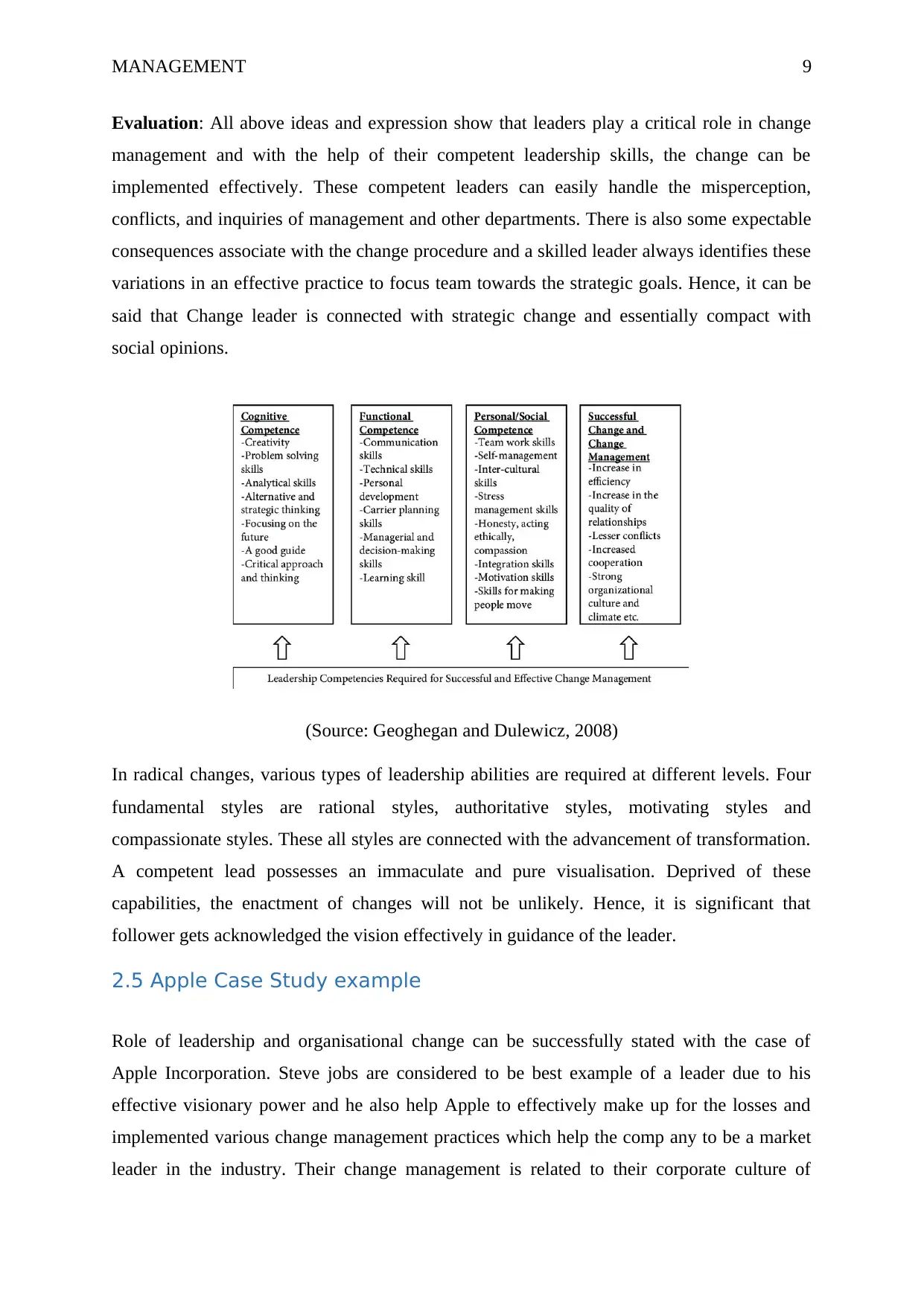
MANAGEMENT 9
Evaluation: All above ideas and expression show that leaders play a critical role in change
management and with the help of their competent leadership skills, the change can be
implemented effectively. These competent leaders can easily handle the misperception,
conflicts, and inquiries of management and other departments. There is also some expectable
consequences associate with the change procedure and a skilled leader always identifies these
variations in an effective practice to focus team towards the strategic goals. Hence, it can be
said that Change leader is connected with strategic change and essentially compact with
social opinions.
(Source: Geoghegan and Dulewicz, 2008)
In radical changes, various types of leadership abilities are required at different levels. Four
fundamental styles are rational styles, authoritative styles, motivating styles and
compassionate styles. These all styles are connected with the advancement of transformation.
A competent lead possesses an immaculate and pure visualisation. Deprived of these
capabilities, the enactment of changes will not be unlikely. Hence, it is significant that
follower gets acknowledged the vision effectively in guidance of the leader.
2.5 Apple Case Study example
Role of leadership and organisational change can be successfully stated with the case of
Apple Incorporation. Steve jobs are considered to be best example of a leader due to his
effective visionary power and he also help Apple to effectively make up for the losses and
implemented various change management practices which help the comp any to be a market
leader in the industry. Their change management is related to their corporate culture of
Evaluation: All above ideas and expression show that leaders play a critical role in change
management and with the help of their competent leadership skills, the change can be
implemented effectively. These competent leaders can easily handle the misperception,
conflicts, and inquiries of management and other departments. There is also some expectable
consequences associate with the change procedure and a skilled leader always identifies these
variations in an effective practice to focus team towards the strategic goals. Hence, it can be
said that Change leader is connected with strategic change and essentially compact with
social opinions.
(Source: Geoghegan and Dulewicz, 2008)
In radical changes, various types of leadership abilities are required at different levels. Four
fundamental styles are rational styles, authoritative styles, motivating styles and
compassionate styles. These all styles are connected with the advancement of transformation.
A competent lead possesses an immaculate and pure visualisation. Deprived of these
capabilities, the enactment of changes will not be unlikely. Hence, it is significant that
follower gets acknowledged the vision effectively in guidance of the leader.
2.5 Apple Case Study example
Role of leadership and organisational change can be successfully stated with the case of
Apple Incorporation. Steve jobs are considered to be best example of a leader due to his
effective visionary power and he also help Apple to effectively make up for the losses and
implemented various change management practices which help the comp any to be a market
leader in the industry. Their change management is related to their corporate culture of
Paraphrase This Document
Need a fresh take? Get an instant paraphrase of this document with our AI Paraphraser
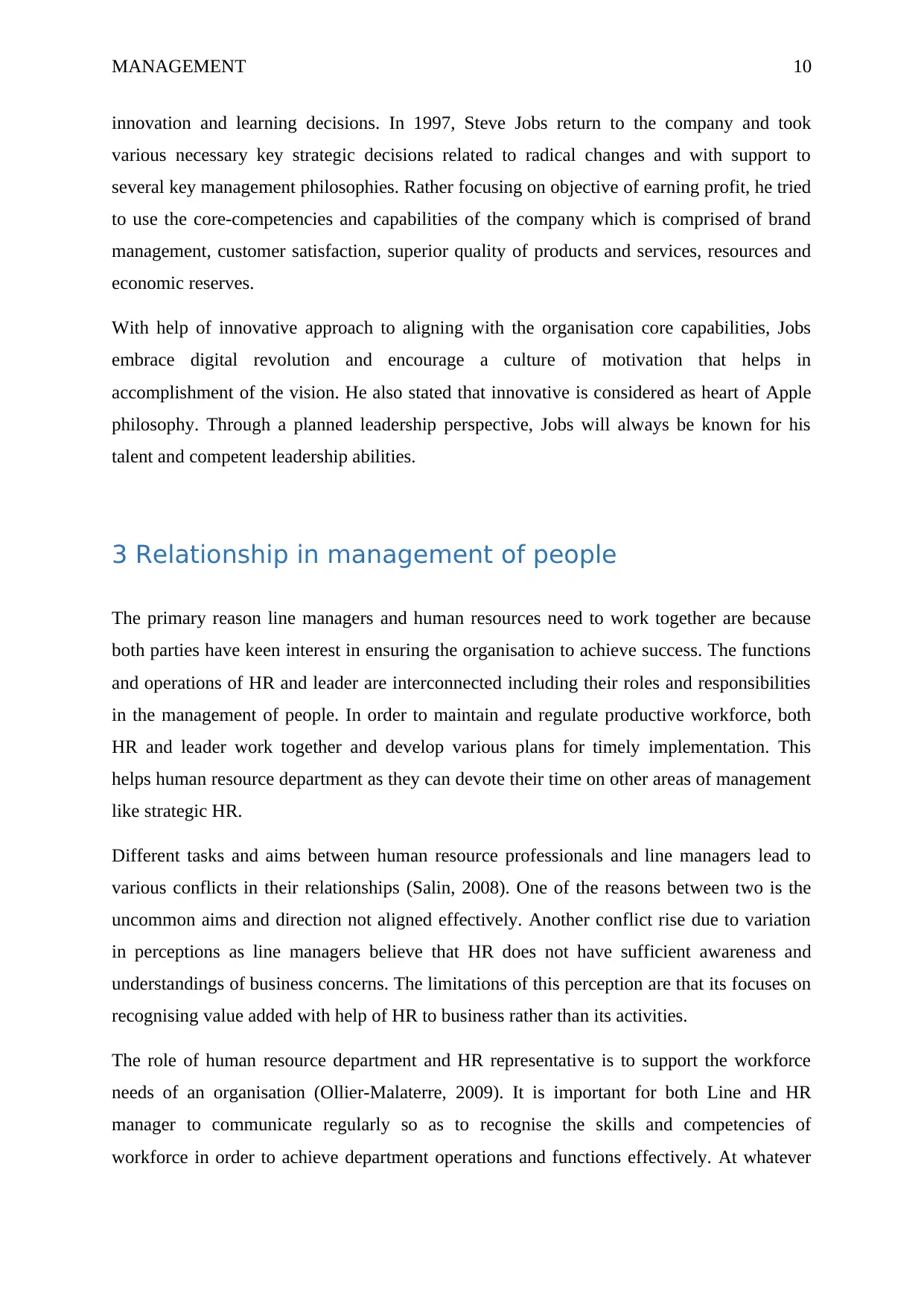
MANAGEMENT 10
innovation and learning decisions. In 1997, Steve Jobs return to the company and took
various necessary key strategic decisions related to radical changes and with support to
several key management philosophies. Rather focusing on objective of earning profit, he tried
to use the core-competencies and capabilities of the company which is comprised of brand
management, customer satisfaction, superior quality of products and services, resources and
economic reserves.
With help of innovative approach to aligning with the organisation core capabilities, Jobs
embrace digital revolution and encourage a culture of motivation that helps in
accomplishment of the vision. He also stated that innovative is considered as heart of Apple
philosophy. Through a planned leadership perspective, Jobs will always be known for his
talent and competent leadership abilities.
3 Relationship in management of people
The primary reason line managers and human resources need to work together are because
both parties have keen interest in ensuring the organisation to achieve success. The functions
and operations of HR and leader are interconnected including their roles and responsibilities
in the management of people. In order to maintain and regulate productive workforce, both
HR and leader work together and develop various plans for timely implementation. This
helps human resource department as they can devote their time on other areas of management
like strategic HR.
Different tasks and aims between human resource professionals and line managers lead to
various conflicts in their relationships (Salin, 2008). One of the reasons between two is the
uncommon aims and direction not aligned effectively. Another conflict rise due to variation
in perceptions as line managers believe that HR does not have sufficient awareness and
understandings of business concerns. The limitations of this perception are that its focuses on
recognising value added with help of HR to business rather than its activities.
The role of human resource department and HR representative is to support the workforce
needs of an organisation (Ollier-Malaterre, 2009). It is important for both Line and HR
manager to communicate regularly so as to recognise the skills and competencies of
workforce in order to achieve department operations and functions effectively. At whatever
innovation and learning decisions. In 1997, Steve Jobs return to the company and took
various necessary key strategic decisions related to radical changes and with support to
several key management philosophies. Rather focusing on objective of earning profit, he tried
to use the core-competencies and capabilities of the company which is comprised of brand
management, customer satisfaction, superior quality of products and services, resources and
economic reserves.
With help of innovative approach to aligning with the organisation core capabilities, Jobs
embrace digital revolution and encourage a culture of motivation that helps in
accomplishment of the vision. He also stated that innovative is considered as heart of Apple
philosophy. Through a planned leadership perspective, Jobs will always be known for his
talent and competent leadership abilities.
3 Relationship in management of people
The primary reason line managers and human resources need to work together are because
both parties have keen interest in ensuring the organisation to achieve success. The functions
and operations of HR and leader are interconnected including their roles and responsibilities
in the management of people. In order to maintain and regulate productive workforce, both
HR and leader work together and develop various plans for timely implementation. This
helps human resource department as they can devote their time on other areas of management
like strategic HR.
Different tasks and aims between human resource professionals and line managers lead to
various conflicts in their relationships (Salin, 2008). One of the reasons between two is the
uncommon aims and direction not aligned effectively. Another conflict rise due to variation
in perceptions as line managers believe that HR does not have sufficient awareness and
understandings of business concerns. The limitations of this perception are that its focuses on
recognising value added with help of HR to business rather than its activities.
The role of human resource department and HR representative is to support the workforce
needs of an organisation (Ollier-Malaterre, 2009). It is important for both Line and HR
manager to communicate regularly so as to recognise the skills and competencies of
workforce in order to achieve department operations and functions effectively. At whatever
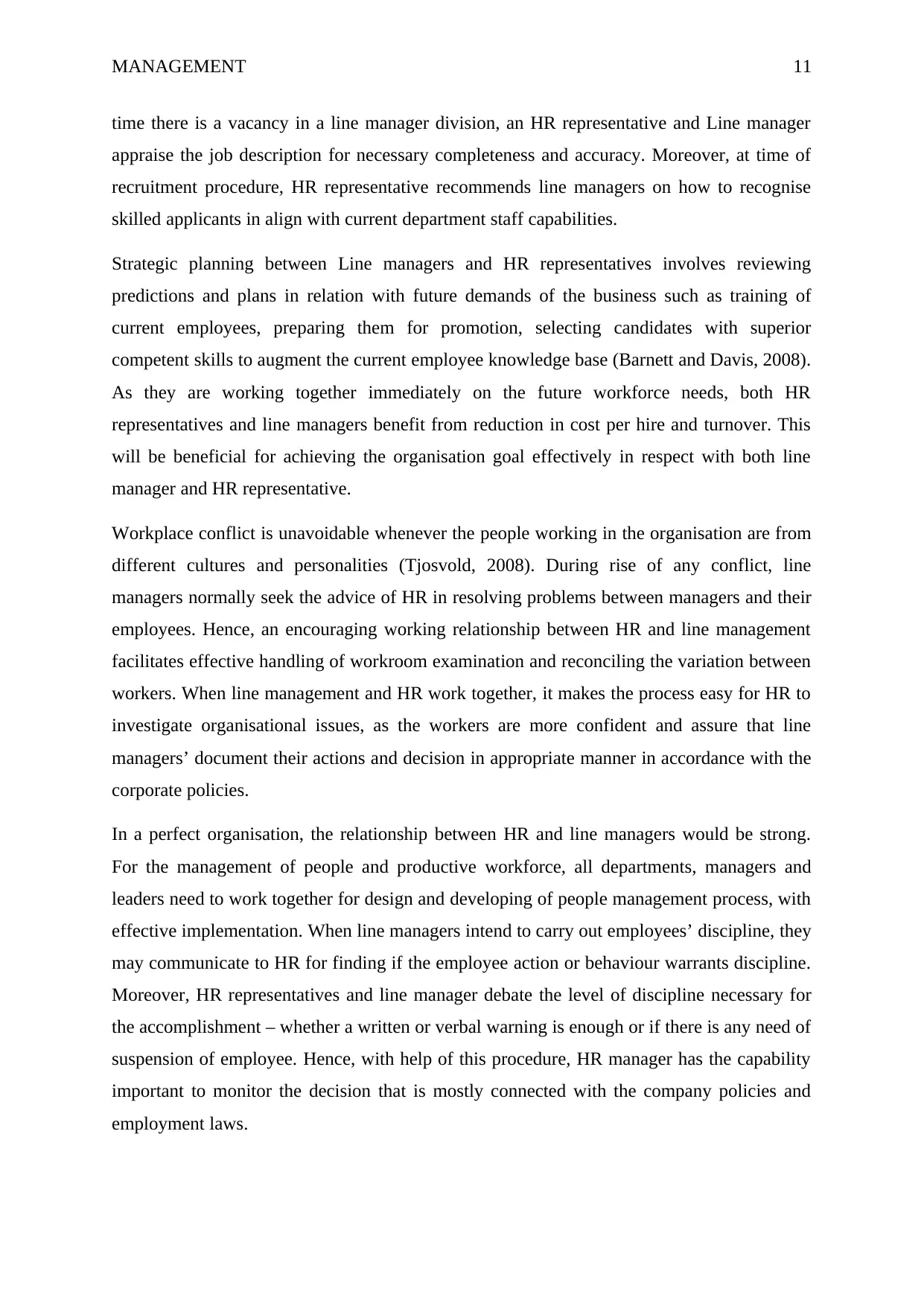
MANAGEMENT 11
time there is a vacancy in a line manager division, an HR representative and Line manager
appraise the job description for necessary completeness and accuracy. Moreover, at time of
recruitment procedure, HR representative recommends line managers on how to recognise
skilled applicants in align with current department staff capabilities.
Strategic planning between Line managers and HR representatives involves reviewing
predictions and plans in relation with future demands of the business such as training of
current employees, preparing them for promotion, selecting candidates with superior
competent skills to augment the current employee knowledge base (Barnett and Davis, 2008).
As they are working together immediately on the future workforce needs, both HR
representatives and line managers benefit from reduction in cost per hire and turnover. This
will be beneficial for achieving the organisation goal effectively in respect with both line
manager and HR representative.
Workplace conflict is unavoidable whenever the people working in the organisation are from
different cultures and personalities (Tjosvold, 2008). During rise of any conflict, line
managers normally seek the advice of HR in resolving problems between managers and their
employees. Hence, an encouraging working relationship between HR and line management
facilitates effective handling of workroom examination and reconciling the variation between
workers. When line management and HR work together, it makes the process easy for HR to
investigate organisational issues, as the workers are more confident and assure that line
managers’ document their actions and decision in appropriate manner in accordance with the
corporate policies.
In a perfect organisation, the relationship between HR and line managers would be strong.
For the management of people and productive workforce, all departments, managers and
leaders need to work together for design and developing of people management process, with
effective implementation. When line managers intend to carry out employees’ discipline, they
may communicate to HR for finding if the employee action or behaviour warrants discipline.
Moreover, HR representatives and line manager debate the level of discipline necessary for
the accomplishment – whether a written or verbal warning is enough or if there is any need of
suspension of employee. Hence, with help of this procedure, HR manager has the capability
important to monitor the decision that is mostly connected with the company policies and
employment laws.
time there is a vacancy in a line manager division, an HR representative and Line manager
appraise the job description for necessary completeness and accuracy. Moreover, at time of
recruitment procedure, HR representative recommends line managers on how to recognise
skilled applicants in align with current department staff capabilities.
Strategic planning between Line managers and HR representatives involves reviewing
predictions and plans in relation with future demands of the business such as training of
current employees, preparing them for promotion, selecting candidates with superior
competent skills to augment the current employee knowledge base (Barnett and Davis, 2008).
As they are working together immediately on the future workforce needs, both HR
representatives and line managers benefit from reduction in cost per hire and turnover. This
will be beneficial for achieving the organisation goal effectively in respect with both line
manager and HR representative.
Workplace conflict is unavoidable whenever the people working in the organisation are from
different cultures and personalities (Tjosvold, 2008). During rise of any conflict, line
managers normally seek the advice of HR in resolving problems between managers and their
employees. Hence, an encouraging working relationship between HR and line management
facilitates effective handling of workroom examination and reconciling the variation between
workers. When line management and HR work together, it makes the process easy for HR to
investigate organisational issues, as the workers are more confident and assure that line
managers’ document their actions and decision in appropriate manner in accordance with the
corporate policies.
In a perfect organisation, the relationship between HR and line managers would be strong.
For the management of people and productive workforce, all departments, managers and
leaders need to work together for design and developing of people management process, with
effective implementation. When line managers intend to carry out employees’ discipline, they
may communicate to HR for finding if the employee action or behaviour warrants discipline.
Moreover, HR representatives and line manager debate the level of discipline necessary for
the accomplishment – whether a written or verbal warning is enough or if there is any need of
suspension of employee. Hence, with help of this procedure, HR manager has the capability
important to monitor the decision that is mostly connected with the company policies and
employment laws.
⊘ This is a preview!⊘
Do you want full access?
Subscribe today to unlock all pages.

Trusted by 1+ million students worldwide
1 out of 18
Related Documents
Your All-in-One AI-Powered Toolkit for Academic Success.
+13062052269
info@desklib.com
Available 24*7 on WhatsApp / Email
![[object Object]](/_next/static/media/star-bottom.7253800d.svg)
Unlock your academic potential
Copyright © 2020–2025 A2Z Services. All Rights Reserved. Developed and managed by ZUCOL.





